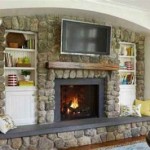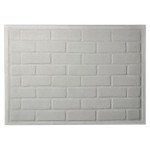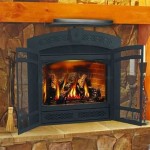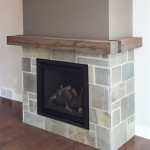Building a Mantel for a Gas Fireplace: A Comprehensive Guide
Gas fireplaces offer a convenient and efficient way to add warmth and ambiance to a home. Unlike traditional wood-burning fireplaces, they eliminate the need for firewood and the associated mess, while providing consistent heat with the turn of a switch. A well-designed mantel not only enhances the aesthetic appeal of a gas fireplace but also serves a practical purpose, providing a focal point and a surface for displaying decorative items. This article provides a comprehensive guide to building a mantel for a gas fireplace, covering planning, material selection, safety considerations, and construction techniques.
Planning and Design Considerations
Before embarking on the construction of a mantel, a thorough planning phase is essential. This involves considering the overall design aesthetic, the dimensions of the fireplace, and the specific requirements of the gas fireplace unit. The design should complement the existing décor of the room and reflect the homeowner's personal style. Whether the desired look is traditional, modern, rustic, or minimalist, the mantel should seamlessly integrate with the surrounding architecture.
Accurate measurements are paramount. These include the width, height, and depth of the fireplace opening, as well as the distance from the fireplace to the ceiling. These measurements will dictate the size and proportions of the mantel. It is crucial to adhere to clearance requirements specified by the gas fireplace manufacturer. These clearances are in place to prevent overheating and ensure safe operation. The manufacturer's instructions will outline the minimum distances required between the fireplace and combustible materials, including the mantel. Ignoring these specifications could lead to a fire hazard.
The design process should also incorporate practical considerations. For instance, the mantel depth should be sufficient to accommodate decorative items, such as picture frames, candles, or vases. The mantel height should be comfortable for viewing and interacting with these items. Furthermore, consider the weight-bearing capacity of the mantel, particularly if heavier objects will be placed on it. If necessary, reinforce the mantel structure to ensure it can safely support the intended load.
Software can be useful to visualize the finished product before commencing any construction work. Programs such as SketchUp allows the user to create a 3D model of the mantel, enabling adjustments to the design and ensuring it meets the intended aesthetic and functional requirements. This process also allows for the identification of any potential problems or conflicts before they arise during construction.
Material Selection
The choice of materials for the mantel significantly impacts its appearance, durability, and cost. Common materials include wood, stone, and composite materials. Wood is a popular choice due to its versatility, availability, cost-effectiveness, and ease of working. Hardwoods, such as oak, maple, and cherry, are durable and visually appealing, while softwoods, such as pine and fir, are more affordable but may require more frequent maintenance. The wood can be stained or painted to match the surrounding décor.
Stone offers a more substantial and elegant look. Natural stone, such as granite, marble, and limestone, is highly durable and adds a touch of luxury. However, natural stone can be expensive and requires specialized tools and techniques for cutting and installation. Cultured stone, a manufactured product that mimics the appearance of natural stone, provides a more affordable alternative.
Composite materials, such as medium-density fiberboard (MDF) and plywood, offer a balance of affordability and durability. MDF is smooth and easy to paint, while plywood provides structural strength. These materials are often used as a substrate for veneer or other decorative finishes. When selecting materials, it is essential to consider the overall design aesthetic, budget, and the level of skill required for working with each material.
In addition to the primary construction materials, consider the hardware. Screws, nails, adhesives, and brackets should be selected based on their strength and compatibility with the chosen materials. Stainless steel hardware is resistant to corrosion and is suitable for use in areas with high humidity. High-quality adhesives will ensure a secure and long-lasting bond between the different components of the mantel.
Construction Techniques
The construction process involves several stages, beginning with cutting the materials to size and assembling the mantel components. Accuracy is crucial throughout the construction process. Utilize a measuring tape and carpenter's square to ensure that all cuts are precise and square. Inaccurate cuts can lead to gaps and misalignment, compromising the structural integrity and aesthetic appeal of the mantel.
For wooden mantels, wood glue and screws are commonly used to assemble the various components. Apply wood glue along the edges of the pieces to be joined, then clamp them together securely. Use screws to reinforce the joints, ensuring that the screws are countersunk to prevent them from protruding above the surface. For stone mantels, mortar or adhesive is used to bond the stones together. Apply the mortar or adhesive evenly and ensure that the stones are level and plumb.
Once the mantel is assembled, it can be finished to enhance its appearance and protect it from the elements. For wooden mantels, sanding is essential to create a smooth surface. Start with a coarse grit sandpaper and gradually work your way to a finer grit. Apply stain or paint to achieve the desired color and finish. Multiple coats may be necessary to achieve the desired depth of color and durability. Apply a clear coat of varnish or polyurethane to protect the finish from scratches and moisture.
Installing the mantel involves attaching it securely to the wall. Locate the wall studs using a stud finder. Use screws or bolts that are long enough to penetrate the studs and provide a secure connection. For heavier mantels, it may be necessary to use additional support brackets. Ensure that the brackets are properly aligned and securely attached to the wall and the mantel. Once the mantel is installed, inspect it carefully to ensure that it is level and plumb. Make any necessary adjustments before proceeding with the final finishing touches.
Safety is of utmost importance throughout the construction process. Always wear safety glasses when cutting or sanding materials to protect your eyes from debris. Use a dust mask or respirator when working with wood or stone dust to prevent respiratory irritation. Wear gloves to protect your hands from sharp edges and chemicals. Use power tools safely and responsibly, following the manufacturer's instructions. Ensure adequate ventilation when working with paints, stains, and adhesives to prevent exposure to harmful fumes.
:max_bytes(150000):strip_icc()/sandandsisal-bdc76ad938a44d28ae9e23ef6c9fa331.jpg?strip=all)
17 Diy Fireplace Mantel Plans

How To Install A Gas Fireplace Framing Finishing Tylynn M

How To Install A Gas Fireplace With Tile Surround And Wood Mantel Sima Spaces

How To Install A Gas Fireplace Framing Finishing Tylynn M
:max_bytes(150000):strip_icc()/ablossominglife-4151b41015a64193a437e981c3aad037.jpg?strip=all)
17 Diy Fireplace Mantel Plans

Diy Fireplace Makeover At Home With The Barkers

Diy Gas Fireplace Surround Modern Remodel

I Built A Fireplace Easier Than Thought

19 Amazing Diy Fireplace Mantel Ideas To Inspire You

How To Build A Faux Fireplace Mantel And Surround The Home Depot
Related Posts








